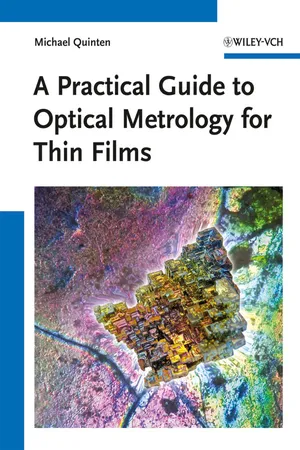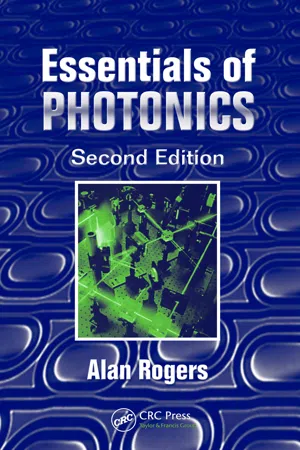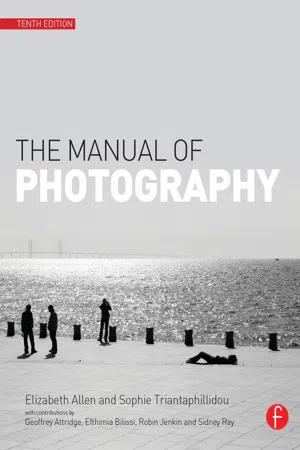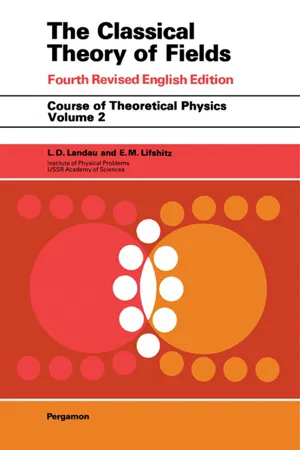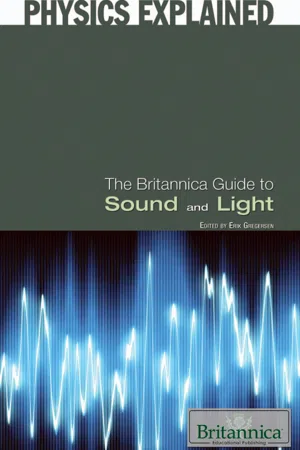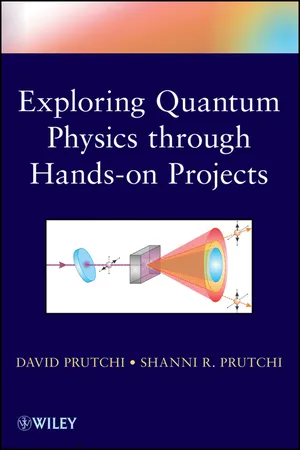Physics
Propagation of Light
Propagation of light refers to the way light travels through space. It can be described as a wave or a stream of particles called photons. Light can propagate through various mediums, such as air, water, or glass, and its behavior is governed by the principles of reflection, refraction, diffraction, and interference.
Written by Perlego with AI-assistance
Related key terms
Related key terms
1 of 4
Related key terms
1 of 3
12 Key excerpts on "Propagation of Light"
- Michael Quinten(Author)
- 2012(Publication Date)
- Wiley-VCH(Publisher)
Chapter 2 Propagation of Light and Other Electromagnetic WavesThis chapter introduces the basics of the Propagation of Light and other electromagnetic radiation in space and matter. Beyond the general properties of electromagnetic waves, we consider mainly the deviations from the straightforward propagation by reflection, refraction, and diffraction since they are important for understanding the optical layer thickness determination and the functioning of the optical measuring devices. Last but not least, propagation in matter also means interaction of the electromagnetic wave with the matter for what we also discuss the dielectric function and the refractive index in this chapter.2.1 Properties of Electromagnetic Waves
When discussing the properties of electromagnetic waves, it seems appropriate to give first a definition of a wave. A wave generally is a process that is periodic in time and space. That means there exists a periodicity T in time after that the wave looks the same as at a certain time point t , and a periodicity R in space where the wave looks the same as at a certain point r :(2.1)Mathematically, A (r ,t ) fulfills the wave equation (in Cartesian coordinates):(2.2)with c being the propagation velocity. That means, in general, we search for a vector with its second derivative in time being proportional to its second derivative in space. The actual solution, however, is additionally determined by the boundary conditions of this differential equation.When talking about electromagnetic waves, we often find, though it is not mandatory, that solutions of the wave equation are harmonic functions in time and space like(2.3)with k = |k | = 2π /|R |, ω = 2π /T , and ϕ an arbitrary constant. The length |R | is called wavelength λ and describes the distance between two successive identical phases of the wave in space, for example, the distance between two maxima or two minima. The propagation velocity corresponds to the vacuum velocity of light c = 299 792 458 m/s. k and ω fulfill the dispersion relation- eBook - ePub
- Alan Rogers(Author)
- 2017(Publication Date)
- CRC Press(Publisher)
Emission, Propagation, and Absorption Processes4.1 Introduction
In this chapter, we shall deal with the various processes by which light and matter interact. It is impossible to overestimate the importance of this subject, because it is only via this interaction that we can even become aware of the existence of light, and certainly we need to understand well the processes of interaction in order to study and to use light.The detailed understanding of the interactive processes requires a deep knowledge of quantum theory, which is beyond the purpose of this book. Much insight can be gained, however, from a combination of classical (i.e., quasi-intuitive) ideas and elementary quantum physics. This is the approach that will be adopted.A familiarity with the ideas in this chapter will ease the path for appreciation of most of the later chapters in the book, but especially Chapters 7 and 9 .We shall begin by considering the nature of light propagation in an optical medium. This uses the classical wave theory of Chapter 2 , which provides a useful picture of the processes involved. The following sections, on optical dispersion and the emission and absorption processes, develop further the ideas introduced in the first section and also provide the groundwork for the more comprehensive treatments in later chapters.4.2 Classical Theory of Light Propagation in Uniform Dielectric Media
Consider the standard expression for the electric field component of an electromagnetic wave (of arbitrary polarization) propagating in the Oz direction in an optical medium of refractive index n :E = E 0 exp [i (ωt − kz )]We know thatand hence may writeω k= c =c 0nE =We may conveniently include both the amplitude attenuation and the phase behaviour of the wave in this expression by defining a complex refractive index:E 0exp[ i ω( t -])n zc 0 - eBook - ePub
- Elizabeth Allen, Sophie Triantaphillidou(Authors)
- 2012(Publication Date)
- Routledge(Publisher)
ray and many optical effects assume light as rays (as in geometric optics).Figure 2.7 Propagation of Light as wavefronts and wavelets.The plane wave is the simplest representation of a three-dimensional wave (Figure 2.8a ), where wavefronts are parallel to each other and perpendicular to the direction of propagation. Light propagating in plane wavefronts is referred to as collimated light. Far enough from the source a small area of a spherical wavefront – described above – resembles a part of a plane wave, as illustrated in Figure 2.8b .The mathematical description of a monochromatic (i.e. single constant frequency) plane wave is the vector equivalent of the expressions describing the simple harmonic motion (see definition in Appendix A ).Light intensity
In practice, the wave oscillations are not usually observed, as their frequency is too high. We observe the power transmitted by the light beam, averaged over some millions of oscillations. The instantaneous light power is proportional to Ψ2 (x, t):The average of this over a long time is equal to the light intensity, or irradiance, I, which is proportional to the square of the amplitude, a, of the electric field:This is the quantity measured by light detectors.Refraction and dispersion
As mentioned in the introduction to wave theory, electromagnetic waves slow down when travelling through media denser than vacuum. A measure of this reduction in speed in transmitting materials such as air, glass and water is the refractive index n - eBook - ePub
Fundamentals of Radio Astronomy
Astrophysics
- Ronald L. Snell, Stanley Kurtz, Jonathan Marr(Authors)
- 2019(Publication Date)
- CRC Press(Publisher)
Chapter 2Propagation of RadiationI N this chapter we describe the interactions between light and matter that are needed to understand how light propagates through matter. As we will discuss in later chapters, we can use the framework developed here to predict the emission produced by an astronomical source and to determine how that radiation might be altered by matter in space as it travels to our telescope. The process by which light propagates through a medium is called radiative transfer. We will discuss in Section 2.1 the transfer of radiation in general, and then in Section 2.2 discuss radiative transfer in an ionized and magnetic medium.2.1Radiative TransferAlthough the interactions between light and matter occur on a microscopic scale, the photons pass through matter on a macroscopic scale. In this section we will produce a heuristic derivation of what is commonly called the equation of radiative transfer. We start this discussion by considering the ways in which matter can alter radiation that passes through it. Once electromagnetic radiation is emitted, if it passes through matter that matter can (1) absorb some of the radiation, (2) emit more radiation, (3) absorb, and then re-emit radiation at a new frequency, or (4) scatter some of the radiation into a new direction.2.1.1Absorption of RadiationWe first concentrate on a medium’s ability to attenuate radiation by absorbing light. In this process the photons are destroyed and the photon energy is converted to internal energy of the absorbing medium. With this in mind, imagine a ray of light from a background source incident on an infinitesimally thin layer of a medium of thickness ds, and consider the attenuation of that radiation by the medium. This situation is illustrated in Figure 2.1 . LetI ν obe the intensity of radiation incident on the medium at frequency ν, and dIν be the change in intensity of the radiation in passing through the layer. Since the medium removes radiation, dIν must be negative. Also, since the medium cannot remove more radiation than is incident on it, the amount of radiation absorbed must depend on the amount of incident radiation. In general, the layer of the medium will remove a certain fraction of the incident radiation. The fraction of incident radiation that is removed must depend on the distance that the radiation travels to pass through the layer, ds - eBook - ePub
- L D Landau(Author)
- 2013(Publication Date)
- Pergamon(Publisher)
CHAPTER 7THE Propagation of Light
Publisher Summary
This chapter reviews the wave Propagation of Light. A plane wave is characterized by the property that its direction of propagation and amplitude are the same everywhere. The wave surfaces of a plane wave are obviously planes perpendicular to the direction of propagation of the wave. The study of the laws of propagation of waves constitutes the domain of geometrical optics, which considers the propagation of waves, and in particular of light, as the propagation of rays, completely divorced from their wave properties. In other words, geometrical optics corresponds to the limiting case of small wavelength, λ → 0. In geometrical optics, the light wave can be considered as a bundle of rays. The rays themselves, however, determine only the direction of propagation of the light at each point; there remains the question of the distribution of the light intensity in space. In studying the passage of beams of rays through optical systems, special interest attaches to bundles whose rays all pass through one point. The point of intersection can lie either on the rays themselves or on their continuations; depending on this, the image is said to be real or virtual. It can be shown that the problem of image formation with the aid of narrow bundles, moving in the neighborhood of the optical axis in a nonaxially-symmetric system, can be reduced to image formation in an axially-symmetric system plus a subsequent rotation of the image thus obtained, relative to the object.§ 53 Geometrical optics
A plane wave is characterized by the property that its direction of propagation and amplitude are the same everywhere. Arbitrary electromagnetic waves, of course, do not have this property. Nevertheless, a great many electromagnetic waves, which are not plane, have the property that within each small region of space they can be considered to be plane. For this, it is clearly necessary that the amplitude and direction of the wave remain practically constant over distances of the order of the wavelength. If this condition is satisfied, we can introduce the so-called wave surface, i.e. a surface at all of whose points the phase of the wave is the same (at a given time). (The wave surfaces of a plane wave are obviously planes perpendicular to the direction of propagation of the wave.) In each small region of space we can speak of a direction of propagation of the wave, normal to the wave surface. In this way we can introduce the concept of rays - eBook - ePub
- Jürgen Jahns, Stefan Helfert(Authors)
- 2012(Publication Date)
- Wiley-VCH(Publisher)
Chapter 4
Light Propagation in Free Space
The term “free-space optics” needs to be clarified since it has two meanings. On the one hand, it stands for light propagation in a homogenous medium without boundaries, in particular, without lateral boundaries (as opposed to propagation in a waveguide). On the other hand, free-space optics describes optical systems that make use of lenses, prisms, gratings, beam splitters, and so on for imaging, spectroscopy, information processing, and many other applications. So, while the first meaning relates to the physical situation of light propagation, the second refers to the realm of optical instruments and systems.A free-space optical system in the latter sense does have boundaries. Unlike in the case of waveguide propagation, these boundaries do not occur in lateral direction but rather in longitudinal direction. Schematically, a free-space optical system can be represented by piecewise unguided propagation and transmission through optical elements like a lens or a grating, for example, or a spatial light modulator (Figure 4.1 ). Hence, in order to understand the fundamentals of free-space optics, we have to study the Propagation of Light through an object and the propagation in a homogeneous medium. Furthermore, in order to start with our interest in miniaturized optics, we shall consider the scaling properties of free-space optical systems.Figure 4.1Schematic presentation of a free-space optical system (imaging setup) consisting of piecewise layers of undisturbed propagation in a homogeneous layer and interaction with an optical element.As an important remark, we would like to emphasize that throughout this text, we assume coherent illumination. This means, in general, we consider a plane (quasi-)monochromatic wave from a laser source to illuminate the object. - eBook - ePub
Making Physics Fun
Key Concepts, Classroom Activities, and Everyday Examples, Grades K?8
- Robert Prigo(Author)
- 2015(Publication Date)
- Skyhorse(Publisher)
So the particle picture of light was back on the scene. Indeed, the nature of light turned out to be much more interesting than an either-or particle or wave reality. Both descriptions are needed for a full picture of light. This complementary picture is known as the wave-particle duality for light. The dual nature of light, propagating as an electromagnetic wave while interacting with matter through particle-like photons, sums up our present understanding of light. This wave-particle duality is now known to be a universal property of nature. Based on an analogy with the dual nature of light, Louis de Broglie (1892–1987) proposed that matter itself (electrons, atoms, etc.) might show the same duality. He proposed that particles such as electrons might have wave-like features. His ideas were soon put to the test and vindicated when experiments revealed the diffraction and superposition of electrons! All forms of light, both visible and nonvisible, share many fascinating characteristics and properties. Light does not need a medium through which to propagate. It can propagate in a vacuum. Light is made up of oscillating and self-sustaining electric and magnetic fields that interact with matter in a particle-like way (photons). Light travels at a constant speed in a vacuum (299,792,458 meters per second). In a transparent material, light travels at a slower speed, with different frequencies traveling at slightly different speeds. In a vacuum and in uniform transparent materials, light travels in straight lines. Some objects reflect light, some absorb light, and some do both. Light bends— refracts —when it propagates from one transparent medium into another. Visible light comes in a narrow but continuous spectrum of frequencies that we detect as different colors (red to violet). “White” light is composed of light of different colors (red to violet). “Black” is the absence of light - eBook - ePub
- Britannica Educational Publishing, Erik Gregersen(Authors)
- 2010(Publication Date)
- Britannica Educational Publishing(Publisher)
No single answer to the question “What is light?” satisfies the many contexts in which light is experienced, explored, and exploited. The physicist is interested in the physical properties of light, the artist in an aesthetic appreciation of the visual world. Through the sense of sight, light is a primary tool for perceiving the world and communicating within it. Light from the Sun warms Earth, drives global weather patterns, and initiates the life-sustaining process of photosynthesis. On the grandest scale, light’s interactions with matter have helped shape the structure of the universe. Indeed, light provides a window on the universe, from cosmological to atomic scales. Almost all of the information about the rest of the cosmos reaches Earth in the form of electromagnetic radiation. By interpreting that radiation, astronomers can glimpse the earliest epochs of the universe, measure the general expansion of the universe, and determine the chemical composition of stars and the interstellar medium. Just as the invention of the telescope dramatically broadened exploration of the cosmos, so too the invention of the microscope opened the intricate world of the cell. The analysis of the frequencies of light emitted and absorbed by atoms was a principal impetus for the development of quantum mechanics. Atomic and molecular spectroscopies continue to be primary tools for probing the structure of matter, providing ultrasensitive tests of atomic and molecular models and contributing to studies of fundamental photochemical reactions.Light transmits spatial and temporal information. This property forms the basis of the fields of optics and optical communications and myriad related technologies, both mature and emerging. Technological applications based on the manipulations of light include lasers, holography, and fibre-optic telecommunications systems.In most everyday circumstances, the properties of light can be derived from the theory of classical electromagnetism, in which light is described as coupled electric and magnetic fields propagating through space as a traveling wave. However, this wave theory, developed in the mid-19th century, is not sufficient to explain the properties of light at very low intensities. At that level a quantum theory is needed to explain the characteristics of light and to explain the interactions of light with atoms and molecules. In its simplest form, quantum theory describes light as consisting of discrete packets of energy, called photons. However, neither a classical wave model nor a classical particle model correctly describes light; light has a dual nature that is revealed only in quantum mechanics. This surprising wave-particle duality is shared by all of the primary constituents of nature (e.g., electrons have both particle-like and wavelike aspects). Since the mid-20th century, a more comprehensive theory of light, known as quantum electrodynamics (QED), has been regarded by physicists as complete. QED combines the ideas of classical electromagnetism, quantum mechanics, and the special theory of relativity. - Bill Woodward(Author)
- 2014(Publication Date)
- Sybex(Publisher)
Even the simplest fiber-optic link is a triumph of innovative design, manufacturing precision, and technical creativity. One of the factors contributing to the high data rates and long transmission distances of fiber optics is knowledge of the principles of light. While the optical fiber is the transmission medium, light is the carrier on which the data is imposed. Its small wavelengths and high transmission velocity make possible bandwidths that would be unimaginable using other forms of transmission. To get the best performance from every part of the fiber-optic link, you must understand the characteristics of light and the factors within the fiber-optic link that affect it.This chapter describes the basic characteristics of light, especially the type of light used in fiber-optic communications. It also discusses the principles and materials that make fiber-optic communications possible, along with some of the problems that must be overcome.In this chapter, you will learn to- Convert various wavelengths to corresponding frequencies
- Convert various frequencies to corresponding wavelengths
- Calculate the amount of energy in a photon using Planck's constant
- Calculate the speed of light through a transparent medium using its refractive index
- Use Snell's law to calculate the critical angle of incidence
- Calculate the loss in decibels from a Fresnel reflection
Light as Electromagnetic Energy
Whether it comes from the sun, an electric bulb, or a laser, all light is a form of electromagnetic energy. Electromagnetic energy is emitted by any object that has a temperature above absolute zero (–273.15° C), which means that the atoms in the object are in motion. The electrons orbiting the atoms pick up energy from the motion, and the energy causes them to move to higher orbits, or energy levels. As they drop back to their original energy levels, they release the energy again. The energy takes two forms: an electrical field and a magnetic field, formed at right angles to each other and at right angles to their path of travel, as shown in Figure 3.1 .The three-dimensional nature of electromagnetic energyFigure 3.1The combination of these electrical and magnetic fields is an electromagnetic wave, which travels through a vacuum or air at approximately 300,000km/s (kilometers per second). It is important to understand the three-dimensional nature of electromagnetic waves because different types of fiber-optic transmission take advantage of these characteristics. How this is done will be discussed in later chapters.- eBook - ePub
- Deng-Ke Yang, Shin-Tson Wu(Authors)
- 2014(Publication Date)
- Wiley(Publisher)
2 Propagation of Light in Anisotropic Optical Media 2.1 Electromagnetic Wave In wave theory, light is electromagnetic waves propagating in space [1–3]. There are four fundamental quantities in electromagnetic wave: electric field, electric displacement, magnetic field, and magnetic induction. These quantities are vectors. In the SI system, the unit of electric field is volt/meter ; the unit of electric displacement is coulomb/meter 2, which equals newton/volt · meter ; the unit of magnetic field is ampere/meter, which equals newton/volt · second, and the unit of magnetic induction is tesla, which equals volt · second/meter 2. In a medium, the electric displacement is related to the electric field by (2.1) where ε o = 8.85 × 10 −12 farad/meter = 8.85 × 10 −12 newton/volt 2 and is the (relative) dielectric tensor of the medium. The magnetic induction is related to the magnetic field by (2.2) where μ o = 4 π × 10 −7 henry/meter = 4 π × 10 −7 volt 2 · second 2 /newton · meter 2 is the permeability of vacuum and is the (relative) permeability tensor of the medium. Liquid crystals are non-magnetic media, and the permeability is close to 1 and approximately we have, where is the identity tensor. In a medium without free charge, the electromagnetic wave is governed by the Maxwell equations: (2.3) (2.4) (2.5) (2.6) When light propagates through more than one medium, at the boundary between two media, there are boundary conditions: (2.7) (2.8) (2.9) (2.10) At the boundary, the normal components of and and the tangential components of and are continuous. These boundary condition equations are derived from the Maxwell equations. Figure 2.1 Schematic diagram showing the electromagnetic fields at the boundary between two media; represents,,, and ; is a unit vector along the normal direction of the interface; n: normal component and t: tangential component. We first consider light propagating in an isotropic uniform medium where and - eBook - ePub
High-Intensity X-rays - Interaction with Matter
Processes in Plasmas, Clusters, Molecules and Solids
- Stefan P. Hau-Riege(Author)
- 2012(Publication Date)
- Wiley-VCH(Publisher)
Chapter 4 Electromagnetic Wave PropagationWhen an x-ray beam irradiates a material, the electric-field distribution and with that photon absorption are determined by wave propagation effects. The energy deposition profile, in turn, determines the nature of the x-ray–matter interaction process. In this chapter we review wave-propagation phenomena in continuous and structured materials, and specifically discuss applications to reflective multilayers and dispersive grazing incidence optics, which are of particular relevance for x-ray optics.4.1 Electromagnetic Waves in MatterThe behavior of electromagnetic fields in matter can be described using Maxwell equations (1.23) –(1.26) . For now, we will limit our discussion to infinitely extended (unbounded), homogeneous, isotropic media. We consider monochromatic plane harmonic waves, which are the simplest and most fundamental one-dimensional electromagnetic waves. They can be written as(4.1)(4.2)The actual physical electric and magnetic field are the real parts of E and H . At each instant in time, E and H are constant on planes defined by r · k = const . We can build arbitrary solutions to the Maxwell equation by linear superpositions of the plane waves (4.1) and (4.2) .We further assume that the medium is isotropic and linear so that it can be described by the permittivity ε (ω), the permeability μ(ω), and the conductivity σ(ω), so that(4.3)(4.4)(4.5)In the general dynamic case, ε0 (ω) is a complex quantity due to absorption losses in the material.The plane wave equations (4.1) and (4.2) have to fulfill Maxwell equations (1.23) to (1.26) . We assume ρ = 0, that is the medium is charge-neutral. Inserting (4.1) and (4.2) into (1.23) to (1.26) - David Prutchi(Author)
- 2012(Publication Date)
- Wiley(Publisher)
Figure 7 , Foucault used a steam turbine to spin a mirror at the rate of 800 rps. He bounced a light beam off the rotating mirror; the beam was then reflected by a stationary mirror 9 m away. By the time the light returned to the rotating mirror, the mirror had rotated a little, causing the light to be deflected a certain amount away from the source.Figure 7 In 1850, Jean Foucault used this setup to measure the speed of light in (a) air and (b) water. He found that light travels more slowly in water than in air, contrary to the prediction of Newton’s particle theory of light.Foucault then placed a water-filled tube with transparent windows along the light path between the mirrors. If, as Newton affirmed, light travels faster in water than in air, the deflection angle would be smaller and the beam would arrive closer to the source.† Instead, Foucault found that introducing water in the optical path further delayed the beam, indicating that light travels more slowly in water than in air, contrary to the prediction of Newton’s particle theory of light.LIGHT AS AN ELECTROMAGNETIC WAVE
Later, in the 1860s, Scottish physicist James Clerk Maxwell identified light as an electromagnetic wave. Maxwell had derived a wave form of the electric and magnetic equations, revealing a wave-like nature of electric and magnetic fields that vary with time.Maxwell figured out that an electric field that varies along space generates a magnetic field that varies in time and vice versa. For that reason, as an oscillating electric field generates an oscillating magnetic field, the magnetic field in turn generates an oscillating electric field, and so on. Together, these oscillating fields form the electromagnetic wave shown in Figure 8 . The way in which an electromagnetic wave travels through space is described by its wavelength λ, while its oscillation in time is described by the wave’s frequency. The frequency f and the wavelength are related through c = λ f, where c is
Index pages curate the most relevant extracts from our library of academic textbooks. They’ve been created using an in-house natural language model (NLM), each adding context and meaning to key research topics.
Explore more topic indexes
Explore more topic indexes
1 of 6
Explore more topic indexes
1 of 4
